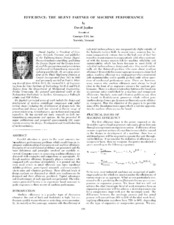| dc.contributor.other | Turbomachinery Symposium (11th : 1982) | |
| dc.creator | Japikse, David | |
| dc.date.accessioned | 2017-10-05T14:50:25Z | |
| dc.date.available | 2017-10-05T14:50:25Z | |
| dc.date.issued | 1982 | |
| dc.identifier.uri | https://hdl.handle.net/1969.1/163691 | |
| dc.description | Paper | en |
| dc.description | Pg. 105-112. | en |
| dc.description.abstract | Careful attention is given to the most common, turbomachinery performance problems which result from an inadequate understanding of component and machine efficiency. Examples of several classical problems are presented and the basic definitions and principles involved are carefully reviewed. Common errors in measuring machine efficiency are discussed with examples and suggestions as appropriate. Although machine efficiency frequently plays a secondary role compared with questions of durability, it is pointed out that even small errors in rated efficiency can cause significant stability problems, power/speed mismatch, and even contribute to noise and vibration problems. Three different levels of design analyses are discussed at which new machines can be designed and their efficiency predicted. Typical advantages and disadvantages of each approach are presented. The information presented herein is an experience based summary to guide engineers in their review of machine performance. | en |
| dc.format.medium | Electronic | en |
| dc.format.mimetype | application/pdf | |
| dc.language.iso | en | |
| dc.publisher | Texas A&M University. Turbomachinery Laboratories | |
| dc.relation.ispartof | Proceedings of the 11th Turbomachinery Symposium | en |
| dc.subject.lcsh | Turbomachines | en |
| dc.title | Efficiency: The Silent Partner Of Machine Performance | en |
| dc.type.genre | Presentation | en |
| dc.type.material | Text | en |
| dc.identifier.doi | https://doi.org/10.21423/R1P38J | |


